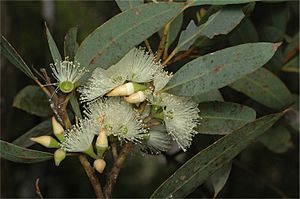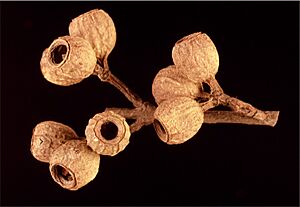Lucky Bay mallee facts for kids
Quick facts for kids Lucky Bay mallee |
|
|---|---|
 |
|
| Eucalyptus ligulata flowers and buds | |
| Scientific classification | |
| Genus: |
Eucalyptus
|
| Species: |
ligulata
|
The Lucky Bay mallee (scientific name: Eucalyptus ligulata) is a special type of Eucalyptus tree. It's a small tree or shrub that grows only in a few places along the southern coast of Western Australia. You can spot it by its smooth bark, long, narrow leaves, and creamy white flowers that grow in small groups. After flowering, it produces interesting cup-shaped or barrel-shaped fruits.
What it Looks Like
The Lucky Bay mallee is a type of mallee, which means it's a small tree or shrub with many stems growing from a woody base. It usually grows to be about 3 to 4 meters (10 to 13 feet) tall. Its bark is smooth and can be pale grey or greenish.
Young plants and new shoots (called coppice regrowth) have leaves that sit directly on the stem without a stalk. These leaves are oblong to lance-shaped, about 6 to 10 centimeters (2.4 to 3.9 inches) long and 2 to 4.5 centimeters (0.8 to 1.8 inches) wide.
As the plant gets older, its adult leaves grow in an alternating pattern along the stem. They are slightly shiny, green to bluish, and narrow, like a spear tip. These leaves are about 4 to 8.5 centimeters (1.6 to 3.3 inches) long and 0.8 to 2 centimeters (0.3 to 0.8 inches) wide. They have a small stalk, called a petiole, which is about 0.5 to 2 centimeters (0.2 to 0.8 inches) long.
The flower buds grow in groups of nine to thirteen in the leaf corners. Each group of buds sits on a stalk called a peduncle, which is about 0.9 to 1.8 centimeters (0.4 to 0.7 inches) long. Each individual bud has its own tiny stalk, called a pedicel, about 0.4 to 0.8 centimeters (0.2 to 0.3 inches) long.
When the buds are ready to open, they are oval or spindle-shaped, about 1 to 1.4 centimeters (0.4 to 0.6 inches) long and 0.4 to 0.5 centimeters (0.2 inches) wide. They have a cone-shaped cap, called an operculum, which is about the same length as the base of the flower (the floral cup).
Lucky Bay mallee flowers are creamy white and usually bloom from March or May to June or October. After the flowers, the plant produces woody fruits. These fruits are like small cups or barrels, with shallow ridges on their sides. The parts that release the seeds (called valves) are tucked inside the rim of the fruit.
How it was Named
The Eucalyptus ligulata was first officially described in 1974 by a botanist named Ian Brooker. He found a sample of the plant near a beach in the Cape Le Grand National Park. The description was then published in a science journal called Nuytsia.
The second part of its scientific name, ligulata, is a Latin word. It means "strap-shaped," which probably refers to the shape of its leaves.
In 2002, another botanist named Dean Nicolle discovered that there are actually two slightly different types, or subspecies, of the Lucky Bay mallee. Both of these subspecies are now officially recognized:
- Eucalyptus ligulata subsp. ligulata
- Eucalyptus ligulata subsp. stirlingica
The stirlingica subspecies has shorter stalks for its individual flower buds and narrower buds. Its cap (operculum) is also much longer than the base of the flower compared to the other subspecies.
Where it Grows and Lives
The ligulata subspecies of the Lucky Bay mallee grows in sandy soil, often near granite rocks. You can find it in Cape Le Grand National Park and Cape Arid National Park.
The stirlingica subspecies grows in areas called mallee shrubland. This type of habitat is found in the Stirling Range National Park.
Conservation Status
Both subspecies of the Lucky Bay mallee are considered "Priority Four" by the Government of Western Australia's Department of Parks and Wildlife. This means that these plants are rare or almost threatened, and efforts are being made to protect them.


